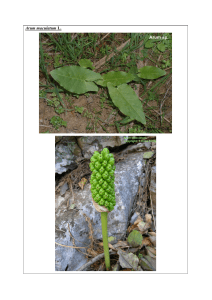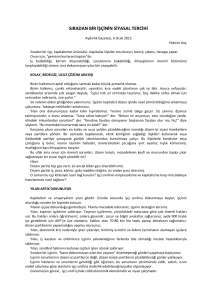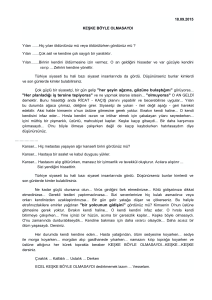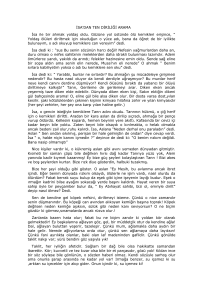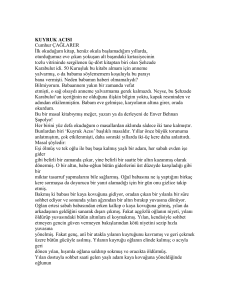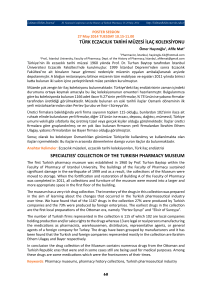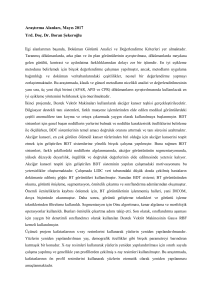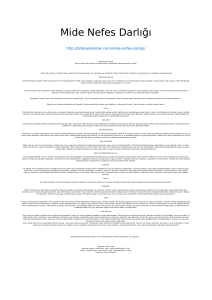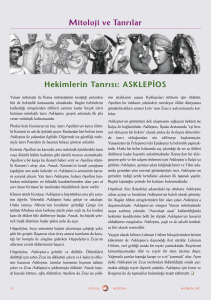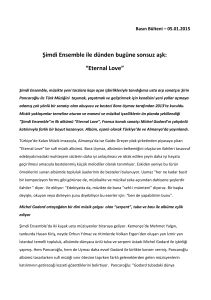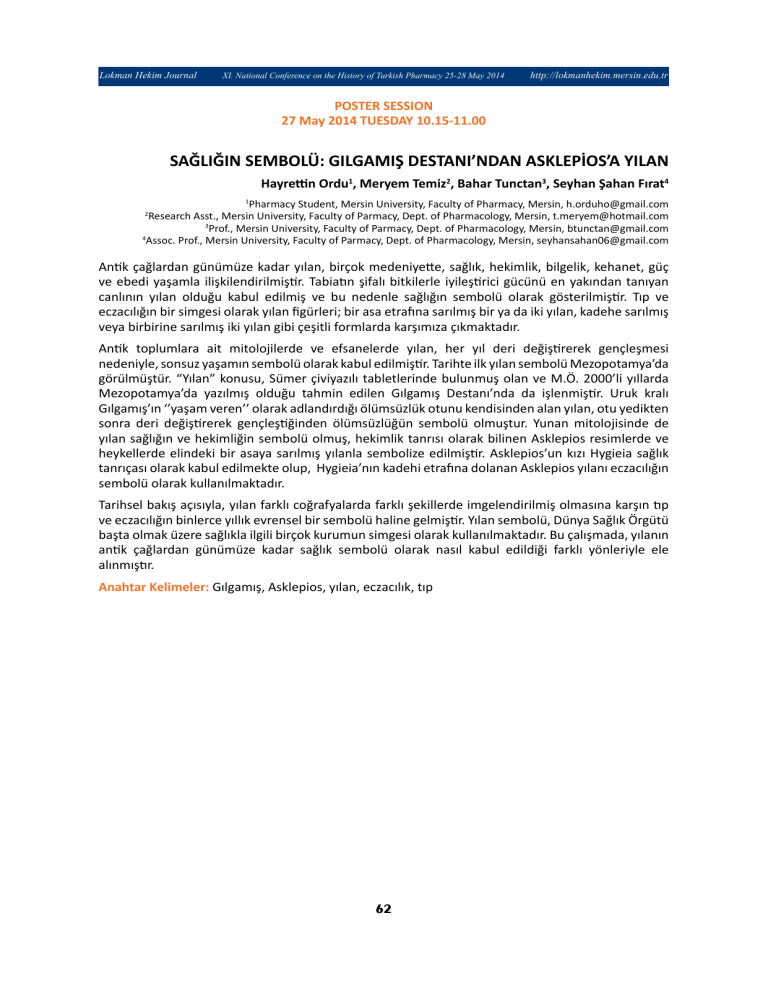
Lokman Hekim Journal
XI. National Conference on the History of Turkish Pharmacy 25-28 May 2014
http://lokmanhekim.mersin.edu.tr
POSTER SESSION
27 May 2014 TUESDAY 10.15-11.00
SAĞLIĞIN SEMBOLÜ: GILGAMIŞ DESTANI’NDAN ASKLEPİOS’A YILAN
Hayrettin Ordu1, Meryem Temiz2, Bahar Tunctan3, Seyhan Şahan Fırat4
1
Pharmacy Student, Mersin University, Faculty of Pharmacy, Mersin, h.orduho@gmail.com
Research Asst., Mersin University, Faculty of Parmacy, Dept. of Pharmacology, Mersin, t.meryem@hotmail.com
3
Prof., Mersin University, Faculty of Parmacy, Dept. of Pharmacology, Mersin, btunctan@gmail.com
4
Assoc. Prof., Mersin University, Faculty of Parmacy, Dept. of Pharmacology, Mersin, seyhansahan06@gmail.com
2
Antik çağlardan günümüze kadar yılan, birçok medeniyette, sağlık, hekimlik, bilgelik, kehanet, güç
ve ebedi yaşamla ilişkilendirilmiştir. Tabiatın şifalı bitkilerle iyileştirici gücünü en yakından tanıyan
canlının yılan olduğu kabul edilmiş ve bu nedenle sağlığın sembolü olarak gösterilmiştir. Tıp ve
eczacılığın bir simgesi olarak yılan figürleri; bir asa etrafına sarılmış bir ya da iki yılan, kadehe sarılmış
veya birbirine sarılmış iki yılan gibi çeşitli formlarda karşımıza çıkmaktadır.
Antik toplumlara ait mitolojilerde ve efsanelerde yılan, her yıl deri değiştirerek gençleşmesi
nedeniyle, sonsuz yaşamın sembolü olarak kabul edilmiştir. Tarihte ilk yılan sembolü Mezopotamya’da
görülmüştür. “Yılan” konusu, Sümer çiviyazılı tabletlerinde bulunmuş olan ve M.Ö. 2000’li yıllarda
Mezopotamya’da yazılmış olduğu tahmin edilen Gılgamış Destanı’nda da işlenmiştir. Uruk kralı
Gılgamış’ın ‘’yaşam veren’’ olarak adlandırdığı ölümsüzlük otunu kendisinden alan yılan, otu yedikten
sonra deri değiştirerek gençleştiğinden ölümsüzlüğün sembolü olmuştur. Yunan mitolojisinde de
yılan sağlığın ve hekimliğin sembolü olmuş, hekimlik tanrısı olarak bilinen Asklepios resimlerde ve
heykellerde elindeki bir asaya sarılmış yılanla sembolize edilmiştir. Asklepios’un kızı Hygieia sağlık
tanrıçası olarak kabul edilmekte olup, Hygieia’nın kadehi etrafına dolanan Asklepios yılanı eczacılığın
sembolü olarak kullanılmaktadır.
Tarihsel bakış açısıyla, yılan farklı coğrafyalarda farklı şekillerde imgelendirilmiş olmasına karşın tıp
ve eczacılığın binlerce yıllık evrensel bir sembolü haline gelmiştir. Yılan sembolü, Dünya Sağlık Örgütü
başta olmak üzere sağlıkla ilgili birçok kurumun simgesi olarak kullanılmaktadır. Bu çalışmada, yılanın
antik çağlardan günümüze kadar sağlık sembolü olarak nasıl kabul edildiği farklı yönleriyle ele
alınmıştır.
Anahtar Kelimeler: Gılgamış, Asklepios, yılan, eczacılık, tıp
62
Lokman Hekim Journal
XI. National Conference on the History of Turkish Pharmacy 25-28 May 2014
http://lokmanhekim.mersin.edu.tr
A SYMBOL OF HEALTH: SERPENT FROM GILGAMESH EPIC TO ASCLEPIUS
Since ancient ages, the snake has been associated with healing, medicine, wisdom, prophecy, power
and eternal life in many civilizations. It has been recognized as a creature closely acquainted to
therapeutically powers of nature with medicinal plants, and for this reason symbol of health has
been referred to it. Serpent figures have various forms as symbols of medicine and pharmacy, such
as: one or two snakes entwined about a staff, a snake wrapped around a bowl or two snakes coiled
around each other.
The serpent was believed to be a symbol of eternal life in the mythology and legends of ancient
societies because it is revived by molting every year. Symbol of snake was first seen in Mesopotamia.
The “Snake” featured in the Epic of Gilgamesh found in Sumerian cuneiform tablets that were
presumably written in Mesopotamia around 2000 BC. The snake that stole the “plant of immortality”
in the possession of King of Uruk, and started to rejuvenate by molting every year to become the
symbol of eternal life. The serpent was also the symbol of healing and medicine in Greek mythology.
Symbolized as a snake-entwined staff in sculptures and pictures; Asclepius is known as god of
healing and medicine. Asclepius’ daughter Hygieia was revered as the goddess of health. The Snake
of Asclepius reaching for the bowl of Hygieia is the international symbol of the pharmacy.
From historical perspective, although the snake has been imaged with different forms in different
regions, it became a universal symbol of medicine and pharmacy for millennia. The serpent is being
used as a symbol by the World Health Organization (WHO) and other health institutes. In this essay
we have attempted to follow snake from different perspectives as it evolved to become the symbol
of medicine and pharmacology.
Keywords: Gilgamesh, Asclepius, snake, serpent, pharmacy, medicine
63

